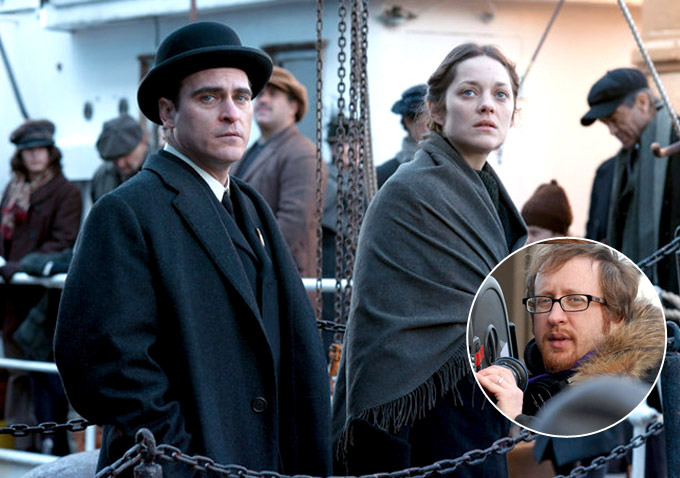
On the surface, filmmaker James Gray’s fifth film, “The Immigrant,” is steeped in the tradition of the director’s chief preoccupations—social class, the nature of tragic characters, stories set in New York City and the immigrant experience (his autobiographically-influenced 1994 debut, “Little Odessa” centers on a tragic family of Russian Jewish immigrants in Coney Island’s Brighton Beach). Set in early 1920s New York, the drama chronicles a Polish immigrant (played by Marion Cotillard) as she arrives at Ellis Island and is eventually deceived by a charming but wicked hustler (Joaquin Phoenix) who manipulates her into a life of prostitution. Her only form of salvation is a magician (Jeremy Renner) who hopes to take her away from that life. But as much as there are superficial James Gray-esque traits, the movie is actually a bold slow-burner that takes the filmmaker in uncharted directions (read our review from the Cannes Film Festival).
“Marion Cotillard is like a silent movie actress; she doesn’t have to say anything. There’s so much compassion for her just by the way that she is, her soul.”
And though Gray’s films to date have always focused on brooding, tragic males torn between duty, circumstance and family, “The Immigrant” is the director’s first movie to use a female lead. Written for Marion Cotillard (the story of how they met is rather amusing and worth reading), several influential touch points culminated for Gray in the creation of the story: a moving opera he saw directed by William Friedkin (Puccini’s “Suor Angelica”), stories from his grandparents about emigrating to America, the copious amounts of period research he did, and of course, wanting to work with France’s most bewitching export.
“She has one of those faces that’s like [Renée Jeanne] Falconetti, you know?” Gray said of Cotillard, likening her to the star of the 1928 film “The Passion of Joan of Arc.” “It’s like a silent movie actress—she doesn’t have to say anything. There’s so much compassion for her just by the way that she is, her soul. She radiates intelligence as well as physical beauty and, god, that’s the rarest quality.”
About the Puccini opera centering on a nun, Gray said he was moved to tears by its beautiful emotional resonance. “And it sort of hit me,” he said. “If we freed ourselves from the macho trappings, freed from the need to be aggressively male, we could address the most emotional sides of ourselves.” It also didn’t hurt that, in his estimation, there were far too few movies starring women in Hollywood. “It’s embarrassing how few movies have women in the center. You know Hollywood pictures used to do it very well. Barbara Stanwyck and movies of the 1940s…starring Katherine Hepburn—female centric melodramas which oftentimes ended rather conveniently but oftentimes were excellent.”
Coupled with these ideas, the filmmaker was also aiming to work outside of his comfort zone. “I was trying to do something that approached a fable instead of a kind of film noir,” he said. “The other films [‘The Yards,’ ‘We Own The Night‘] for all of their trappings are kind of noirs. I guess ‘Two Lovers’ was the first step outside the noir range, but this I wanted to be like a beautiful little jewel, I didn’t want it to be so obsessed with the darkness.”

Citing cinematic influences Robert Bresson, Federico Fellini, Carl Theodor Dreyer, Michael Cimmino’s “Heaven’s Gate” and more, “looking backwards is the way forward” is one of Gray’s mantras. Almost none of his influences are contemporary, and yet they often help in creating something quite modern in tenor and emotion. “What I had hoped for is to make something very much in the tradition of a 1950s Italian movie. I always found those films so emotionally involving,” he said, singling out “La Strada” and other early neorealist, less fanciful Fellini films of this era. “And combine that European tradition with a kind of opera. But that’s usually mistaken for meaning over-the-top and melodramatic. What I mean by operatic is: big emotions, deeply felt.”
The director is also hilariously aware that citing such lofty inspirations are going to get him in trouble in certain circles, but he is, if anything, totally sincere. “You know it’s so hard to reference these people—it sounds so pretentious, like you think you’re as good as they are or whatever, but my attitude is always ‘steal from the best,’ you know?”
Spawned from personal experiences his grandparents and relatives shared with him—his great grandfather ran a restaurant on the Lower East Side and ran into all kinds of unsavory types—while not an autobiographical film, Gray believes a personal investment in story often gets you closest to creating a genuine emotional experience. Having made films never quite in vogue his entire career, it’s a tenet that he still subscribes to.
Gray cites John Cassavetes and Martin Scorsese as American filmmakers who opened the door to making personal films stateside. “The idea was to try and mine your own life for as much as you possibly could for material. The closer you can get to being personal, the better the work is or the more interesting the work is,” Gray explained. “Francis Ford Coppola once said, ‘You should always make personal films because there’s only one of you, and the more personal you get, the more original you get.’ ”
“The Immigrant” makes its North American premiere at the New York Film Festival this week. The film will be released sometime in the spring of 2014 by Radius-TWC. Watch some clips from the film here and here.


